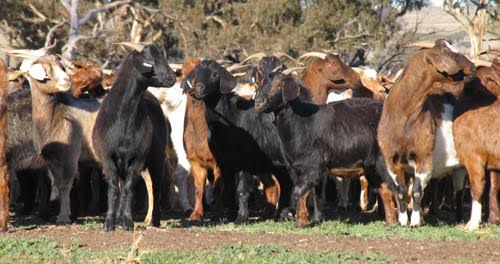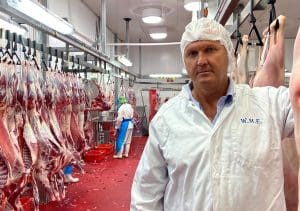
Rangeland goats.
WITH strong global demand for goats and a need for consistent supply, some producers have started researching the possibility of putting the rangeland animals into feedlots.
Processing capacity is expected to increase significantly this year in the large goat growing areas of western Queensland and New South Wales. The area has seen many producers moving into managing goats behind exclusion fences rather than harvesting wild rangeland goats.
Western Meat Exporters (WME) in Charleville is expecting to complete an expansion in the middle of this year and Thomas Food International has purchased a dormant plant at Bourke with plans to re-open it. Sheep Central is expecting more details on the opening plans soon.
WME managing director Campbell McPhee said with more processing capacity and employees to maintain – the company had made enquiries about feeding goats.

Western Meat Exporters managing director Campbell McPhee.
“With the exclusion fences going up and more goats behind wire, people have started backgrounding– buying young billies and growing them out on natural pastures and crops,” Mr McPhee said.
“We’ve had discussions with a few current feedlot operators and lot of them are now doing feasibility studies on goats.
“The more we can have access to stock all year round, the better it will be for our operation – especially with retention of labour being such a challenge. That also helps us from an ‘economy-of-scale’ perspective and keeps our throughput costs lower.”
Mr McPhee said the lotfeeding industry had been moving further west, with several operations around the town of St George – about 400km from Charleville.
“There is already a lot of lamb feedlots around St George and we have also met with lamb feeders in Toowoomba to see what their plans were,” he said.
“Maybe some of those sheep or lamb lotfeeders might consider taking on some goats. Some of the backgrounders have also been feeding grain in the paddock to make sure they don’t go backwards.”
Paddock-fed pellets working well
St George-based Grant Daniel Long agent Anthony Hyland has been working with closely with goat producers and lamb lotfeeders in recent years. He said people in the area had been trying to find ways to feed grain to goats.
“There’s people who have tried putting them in feedlots without too much success. But when they’re in a 3,000-acre paddock with plenty of browse and a natural grazing environment and having feed bins in those paddocks it works a lot better,” Mr Hyland said.
“With that, marketing is playing a lot bigger role in the goat industry now than it was four-years-ago. People are scanning and sending empty nannies to the works, they’re drafting the weaners on weight, sending some to the meatworks and treating the smaller animals like a mob of steers.”
Mr Hyland said along with goats being suited to mulga and gidgee forests in the area, the increase in processing capacity gave producers confidence in the industry.
“Probably the biggest push back into small stock in our area is the ability to produce year-round with goats rather than half a season with cattle – especially when it is dry. Goats also help where re-growth is a concern and browse in country where cattle won’t,” he said.
“We also have the pimelea weed, which has a big impact on cattle in a bad season and doesn’t bother the goats as much. With the dry seasons that we’ve had they are a good option.”

HAVE YOUR SAY